- Home
- About
- Map
- Trips
- Bringing Boat West
- Migration West
- Solo Motorcycle Ride
- Final Family XC Trip
- Colorado Rockies
- Graduates' XC Trip
- Yosemite & Nevada
- Colorado & Utah
- Best of Utah
- Southern Loop
- Pacific Northwest
- Northern Loop
- Los Angeles to NYC
- East Coast Trips
- Martha's Vineyard
- 1 Week in Quebec
- Southeast Coast
- NH Backpacking
- Martha's Vineyard
- Canadian Maritimes
- Ocracoke Island
- Edisto Island
- First Landing '02
- Hunting Island '02
- Stowe in Winter
- Hunting Island '01
- Lake Placid
- Chesapeake
- Provincetown
- Hunting Island '00
- Acadia in Winter
- Boston Suburbs
- Niagara Falls
- First Landing '99
- Cape Hatteras
- West Coast Trips
- Burning Man
- Utah Off-Roading
- Maui
- Mojave 4WD Course
- Colorado River Rafting
- Bishop & Death Valley
- Kauai
- Yosemite Fall
- Utah Off-Road
- Lost Coast
- Yosemite Valley
- Arizona and New Mexico
- Pescadero & Capitola
- Bishop & Death Valley
- San Diego, Anza Borrego, Joshua Tree
- Carmel
- Death Valley in Fall
- Yosemite in the Fall
- Pacific Northwest
- Utah Off-Roading
- Southern CA Deserts
- Yosemite & Covid
- Lake Powell Covid
- Eastern Sierra & Covid
- Bishop & Death Valley
- Central & SE Oregon
- Mojave Road
- Eastern Sierra
- Trinity Alps
- Tuolumne Meadows
- Lake Powell Boating
- Eastern Sierra
- Yosemite Winter
- Hawaii
- 4WD Eastern Sierra
- 4WD Death Valley +
- Southern CA Deserts
- Christmas in Tahoe
- Yosemite & Pinnacles
- Totality
- Yosemite & Sierra
- Yosemite Christmas
- Yosemite, San Diego
- Yosemite & North CA
- Seattle to Sierra
- Southwest Deserts
- Yosemite & Sierra
- Pacific Northwest
- Yosemite & South CA
- Pacific Northwest
- Northern California
- Southern Alaska
- Vancouver Island
- International Trips
- Index
- Tips
- Books
- Photos/Videos
- Search
- Contact
Galapagos - North Seymour Island, Ecuador
Friday, March 17, 2023 - 2:30pm by Lolo
miles and hours from our last stop - 1 night stay
Travelogue
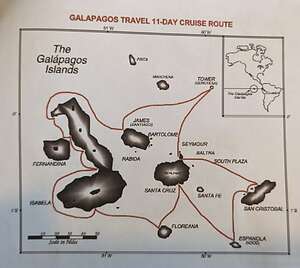 Map of our 11-day cruiseAs I mentioned in the Overview, this was not our first attempt at a “once-in-a-lifetime” trip to the Galapagos Islands. Almost 3 years ago, to the date, on March 12, 2020, we were packed and ready to leave for the airport where we would begin our journey to the Galapagos Islands on a Gate 1 tour.
Map of our 11-day cruiseAs I mentioned in the Overview, this was not our first attempt at a “once-in-a-lifetime” trip to the Galapagos Islands. Almost 3 years ago, to the date, on March 12, 2020, we were packed and ready to leave for the airport where we would begin our journey to the Galapagos Islands on a Gate 1 tour.
Just as we were about to head out the door, something made me check the Gate 1 website, only to discover that the tour, which was to begin in 2 days (we were going early) was canceled. We were so close to actually getting to Ecuador where we would find no tour guide to greet us.
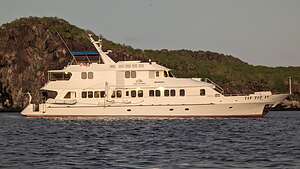 Tip Top IVWe all know what happened over the next 2 years - basically travel stopped while the world waited for the pandemic to end.
Tip Top IVWe all know what happened over the next 2 years - basically travel stopped while the world waited for the pandemic to end.
As things began to open up again, we thought about reimplementing our trip. However, since that time, we had talked to various people and researched other tours and came to the conclusion that the Gate 1 tour (which included only 3 nights on the Galapagos Islands) was not going to be enough.
After much research, Herb came to the conclusion that a longer photography-focused tour made the most sense for us. That’s when he discovered Tui de Roy, the legendary Galapagos photographer that was brought to the Galapagos by her Belgian parents when she was 2 years old. Her father gave her her first camera when she was in her early teens, and she hasn’t stopped photographing the islands since. Over 5 decades and tens of thousands of photos later, she has been awarded a place as one of the top 20 wildlife photographers in the world.
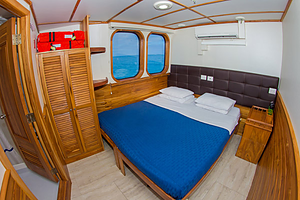 Our cabin on the Tip Top IVWhen Herb found that Tui was the photography guide on a Galapagos Travels 11-day Galapagos Islands tour, we knew we found the tour for us. The opportunity to spend 11 days exploring and photographing this amazing place with the best of the best was very exciting.
Our cabin on the Tip Top IVWhen Herb found that Tui was the photography guide on a Galapagos Travels 11-day Galapagos Islands tour, we knew we found the tour for us. The opportunity to spend 11 days exploring and photographing this amazing place with the best of the best was very exciting.
Our home for the 11 days was the Tip Top IV, a 125-foot yacht which held 15 passengers, 7 crew members, one Naturalist Guide (Monica), and Tui de Roy (Photography Guide). During those 11 days, we would visit 10 different islands, each with its own sometimes overlapping, but often unique, flora and fauna
Day 1 - Arrival and North Seymour Island
This was the big day - our flight to the Galapagos Islands!!!
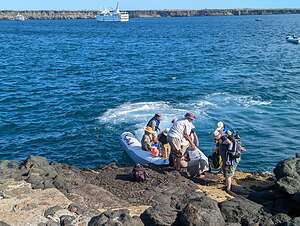 Our first dry landingThere was lots of extra hurdles to go through at the Quito airport to meet the restrictions and security inspections required by the Galapagos National Park, mostly to ensure that we were not bringing anything to the islands that we shouldn’t, specifically, agricultural or plant materials or any unprocessed food products, so as not to affect the unique and pristine ecosystems.
Our first dry landingThere was lots of extra hurdles to go through at the Quito airport to meet the restrictions and security inspections required by the Galapagos National Park, mostly to ensure that we were not bringing anything to the islands that we shouldn’t, specifically, agricultural or plant materials or any unprocessed food products, so as not to affect the unique and pristine ecosystems.
Upon arrival at Baltra airport, we were greeted by Monica, our Naturalist Guide, who we would learn to love over the next 11 days.
Before we knew it, we were transferred by bus to the yacht, which almost immediately lifted anchor and headed to North Seymour Island, officially marking the start of our 11-day Galapagos cruise.
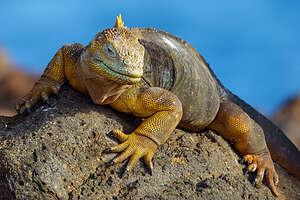 Our first land iguanaWe were shown to our lovely cabin on the upper deck, and barely started unpacking before the bell down below rang, summoning us to come down prepared for our first shore landing. The boat had already moved and anchored off of North Seymour Island white we were trying to unpack.. Wow! These people meant business.
Our first land iguanaWe were shown to our lovely cabin on the upper deck, and barely started unpacking before the bell down below rang, summoning us to come down prepared for our first shore landing. The boat had already moved and anchored off of North Seymour Island white we were trying to unpack.. Wow! These people meant business.
This one was to be a dry landing, meaning the panga would back us right up onto the shore allowing us to get ashore without getting our feet, as opposed to a wet landing where we would have to step into the surf. Both were fine, and we quickly learned to trust the panga drivers and use the “Galapagos handshake” (grasping forearms rather than hands) to get safely on and off the boat.
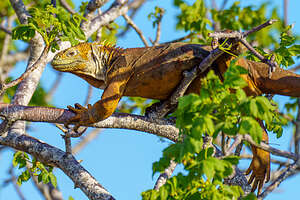 Have to remember to look upAs we got off the panga, I remember wondering if we would see any interesting wildlife. Well, that concern was quickly laid to rest as we were greeted by a Galapagos-style welcoming committee: land iguanas, frigatebirds, and adorable blue-footed boobies. Not only would we see them, but they would approach us like old friends.
Have to remember to look upAs we got off the panga, I remember wondering if we would see any interesting wildlife. Well, that concern was quickly laid to rest as we were greeted by a Galapagos-style welcoming committee: land iguanas, frigatebirds, and adorable blue-footed boobies. Not only would we see them, but they would approach us like old friends.
The first resident of North Seymour that we met was the land iguana, who I came to love as a photo subject, especially because it couldn’t fly away and would happily sit still for me.
In the early 1930s, there were no land iguanas on North Seymour island, but an amateur naturalist named Allan Hancock moved some over from neighboring Baltra Island. They flourished, mostly because the plants on the island had not yet evolved natural defenses against them (evolution at work again). Today there are 2,500 of them on the island.
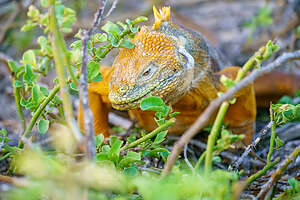 Can't get enough of these land iguanasBy the 1950s, land iguanas had gone extinct on Baltra from U.S. soldiers stationed there during WWII hunting them. The favor was returned and North Seymour iguanas were re-introduced to Baltra.
Can't get enough of these land iguanasBy the 1950s, land iguanas had gone extinct on Baltra from U.S. soldiers stationed there during WWII hunting them. The favor was returned and North Seymour iguanas were re-introduced to Baltra.
Although land iguanas look like scary prehistoric creatures, they are very trusting and docile (when not mating). Plus, they are vegetarians, so they were not interested in me as a lunch entree. Rather they feed on prickly pear cactus, spines and all, which provide them with both food and water.
They are actually quite beautiful (in their own way), about 4 or 5-feet long, with yellow and white bumpy skin and a spiny dorsal crest along their neck and back. They look like they are wearing long-sleeve sweaters that stop at the wrist. Where the sweater ends the very sharp claws on their toes (or hands?) begin.
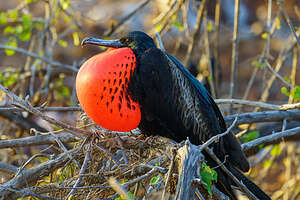 Magnificent FrigatebirdThe other thing I loved about them was that they always seem to have this smirky grin on their face, as if they are more amused about me than I was about them.
Magnificent FrigatebirdThe other thing I loved about them was that they always seem to have this smirky grin on their face, as if they are more amused about me than I was about them.
They are best to photograph at eye level, so I was very glad we brought along knee pads so that we could get down to their level - $20 volleyball pads on Amazon.
Land iguanas are easy to find during the day, because they are cold-blooded and need to absorb heat from the sun by basking on the volcanic rock. At night they crawl into burrows that they have dug to conserve the body heat they have accumulated during the day.
.thumbnail.jpg) Blue-footed boobies beginning their courtship ritualWe actually found one fairly large land iguana up in the upper branches of a tree. I didn’t realize they did that but they certainly have the claws to be good climbers. I have heard about Florida iguanas falling out of trees when the temperature drops because they are cold-blooded and become cold-stunned and lose their grip. Not sure if that happens in the Galapagos, but it would be interesting to photograph, or better yet, video.
Blue-footed boobies beginning their courtship ritualWe actually found one fairly large land iguana up in the upper branches of a tree. I didn’t realize they did that but they certainly have the claws to be good climbers. I have heard about Florida iguanas falling out of trees when the temperature drops because they are cold-blooded and become cold-stunned and lose their grip. Not sure if that happens in the Galapagos, but it would be interesting to photograph, or better yet, video.
As we continued along the trail, it curved away from the shore and into the interior of the island, we met our first Gelapagos bird, the Magnificent Frigatebird. “Magnificent” is actually part of its name. There is also a Great Frigatebird, which we would also soon see. The Great frigatebird has a green sheen on the scapular feathers and a white collar on the neck while the Magnificent is much bigger and has a purple sheen on its scapular feathers.
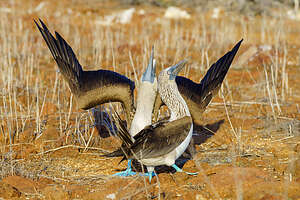 Continuing with the courtship ritualNorth Seymour Island is home to the largest colony of Magnificent Frigatebirds in the entire Galapagos.
Continuing with the courtship ritualNorth Seymour Island is home to the largest colony of Magnificent Frigatebirds in the entire Galapagos.
We were fortunate to be here in March during their breeding season, when they perform their famous courtship ritual, during which the males inflate their red chest globes in order to attract the females. It’s crazy! It looks like a huge red balloon is attached to their chest. The females are attracted to those males that have the the brightest and most long-lasting throat pouch.
Frigatebirds mate just once a year and lay only one egg that takes 50 days to hatch. The chicks then spend a whole year with the parents, a particularly long period of time for a seabird.
.thumbnail.jpg) Making his not too subtle moveWhile other Galapagos birds dive for their lunch, Frigatebirds can’t get wet, because their preen gland doesn’t produce enough oil to waterproof their wings. So, they have to be pirates, surviving by stealing food from other diving birds, especially the blue-footed boobies whom they harass in mid-air until they drop their food, sometimes because they are so stressed that they vomit. The frigatebird then swoops down and plucks the dropped food out of the air.
Making his not too subtle moveWhile other Galapagos birds dive for their lunch, Frigatebirds can’t get wet, because their preen gland doesn’t produce enough oil to waterproof their wings. So, they have to be pirates, surviving by stealing food from other diving birds, especially the blue-footed boobies whom they harass in mid-air until they drop their food, sometimes because they are so stressed that they vomit. The frigatebird then swoops down and plucks the dropped food out of the air.
Their wings are massive and they have a deeply forked tail, allowing for speed and graceful aerial acrobatics, an adaptation that allows them to be very successful pirates. Plus, not having enough oil to secret on their wings has also provided them with the advantage of being lighter and more maneuverable, another useful trait for an air pirate.
Evolution is so neat!
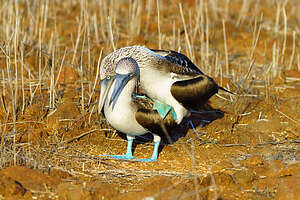 Bingo!While the word Galapagos means Tortoise, the most famous and popular of the creatures to see on the Galapagos Islands are the adorable Blue-Footed Boobies, given their name “bobos” (clowns) by Spanish sailors because of their unusually colored feet and their silly behavior. Their distinctly bright blue color of their feet comes from carotenoid pigments obtained from their fresh fish diet.
Bingo!While the word Galapagos means Tortoise, the most famous and popular of the creatures to see on the Galapagos Islands are the adorable Blue-Footed Boobies, given their name “bobos” (clowns) by Spanish sailors because of their unusually colored feet and their silly behavior. Their distinctly bright blue color of their feet comes from carotenoid pigments obtained from their fresh fish diet.
Continuing along the inland trail, we came upon a major blue-footed booby nesting area.
The blue-footed boobies were very fun to watch, especially during their mating season when they perform their famous courtship dance. During my pre-trip research I had been disappointed to learn that this takes from June to August, but they must not have gotten the memo because here they were in full swing on North Seymour Island in March.
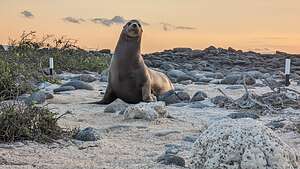 Galapagos Sea LionTheir elaborate courtship ritual begins with the male presenting the female with a small stick or stone. He then tips his beak up to the sky with wings behind his back, while he marches around the female lifting his feet (which he is obviously very proud of) in a high-stepping strut, pointed at a 45 degree angle. The bluer the feet, the more attractive he is to the female. The female’s feet are even bluer than his.
Galapagos Sea LionTheir elaborate courtship ritual begins with the male presenting the female with a small stick or stone. He then tips his beak up to the sky with wings behind his back, while he marches around the female lifting his feet (which he is obviously very proud of) in a high-stepping strut, pointed at a 45 degree angle. The bluer the feet, the more attractive he is to the female. The female’s feet are even bluer than his.
We were fortunate to actually be able to take photos and videos pretty close up of them doing this. I was in charge of video, but just when things were getting hot, I fumbled with my phone and missed taking the video of the actual copulation. I can be excused, however, because it literally only took 10 seconds. I think Herb did get some photos though.
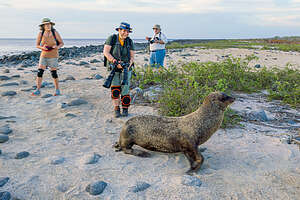 Making friends with a friendly fur sealI did manage to capture some drama afterwards though, when another blue-footed boobie flew in and a fight broke out. Not sure if the extra boobie was a male or a female, but they definitely felt put out by something.
Making friends with a friendly fur sealI did manage to capture some drama afterwards though, when another blue-footed boobie flew in and a fight broke out. Not sure if the extra boobie was a male or a female, but they definitely felt put out by something.
The female will lay two to three eggs, and both parents will take turns using their large feet to incubate them while the other watches for predators, such as the Galapagos Hawk. The egg takes about 45 days to hatch and then they are fed regurgitated fish by both parents. They stay with their parents about 2 months before setting out on their own.
We would see blue-footed boobies incubating their eggs later on this trip when we got to Española Island.
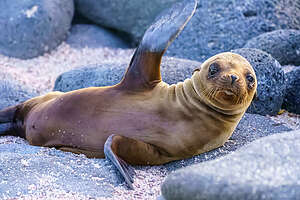 Fur Seals bidding us farewellWe met some Galapagos Sea Lions and Fur Seals on the beach back where the panga would pick us up.
Fur Seals bidding us farewellWe met some Galapagos Sea Lions and Fur Seals on the beach back where the panga would pick us up.
Although land iguanas, frigatebirds, and blue-footed boobies were animals the likes of which we had never seen before, sea lions were something we were very familiar with in California, except these were a bit smaller. In fact, the ones on the Galapagos were originally considered a subspecies of the California ones, but have now attained full species recognition.
Galapagos Sea Lions are extremely friendly and playful and we would spend much time snorkeling with them later on the trip. The bulls, however, can be quite aggressive, constantly defending his shoreline territory and harem of females. We would have a few close encounters with them later in the trip.
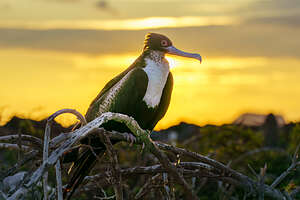 Giant FrigatebirdGalapagos Fur Seals, with their double coat of insulation, seems a bit out of place on the equator. They kind of found their way here north along the Humboldt Current during the Ice Age and became isolated here after the waters warmed and the glaciers melted, eventually becoming an endemic species.
Giant FrigatebirdGalapagos Fur Seals, with their double coat of insulation, seems a bit out of place on the equator. They kind of found their way here north along the Humboldt Current during the Ice Age and became isolated here after the waters warmed and the glaciers melted, eventually becoming an endemic species.
They have some challenges. Firstly, to cope with the heat when they are on land they need to seek out shady shelter in the grottos along rocky shores. Secondly, sharks find them quite tasty, so they fish at night to avoid them and to take advantage of the greater number of fish near the surface at night.
A particularly friendly one waved goodbye to us as we got back on our panga.
Wow! We had seen land iguanas, magnificent frigatebirds inflating a red balloon on their chest, great frigatebirds, blue-footed boobies mating, Galapagos sea lions, and Galapagos fur seals. The trip could be over now and I would be satisfied.
Then it was back on board our ship, a delicious dinner, and our nightly briefing as to what to expect tomorrow. We were exhausted and still not fully unpacked.
Recap of creatures we saw today: land iguanas, magnificent frigatebirds inflating a red balloon on their chest, great frigatebirds, blue-footed boobies mating, Galapagos sea lions, and Galapagos fur seals.
- ‹ previous
- 3 of 13
- next ›
Galapagos - North Seymour Island location map in "high definition"
Javascript is required to view this map.
